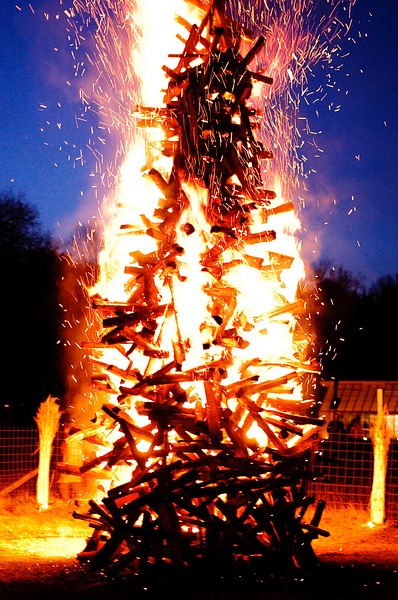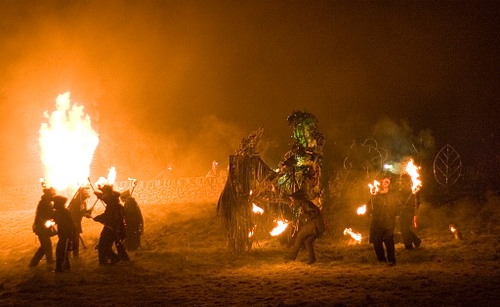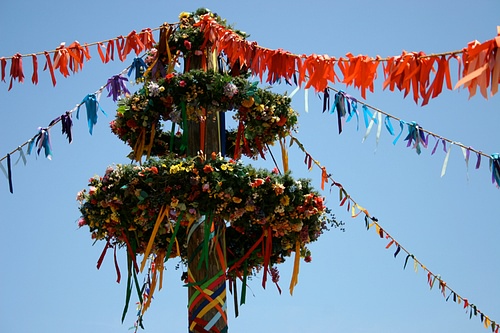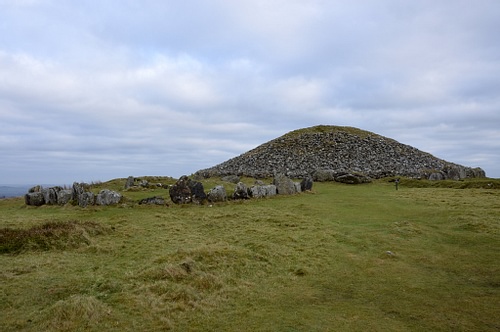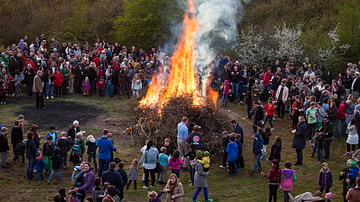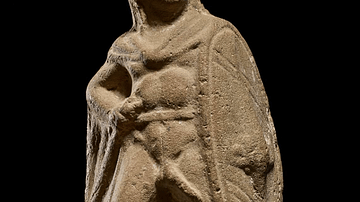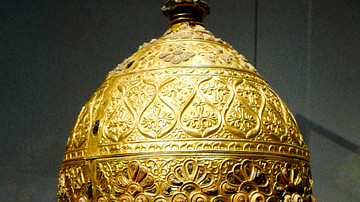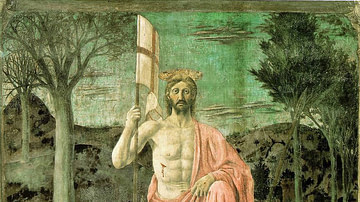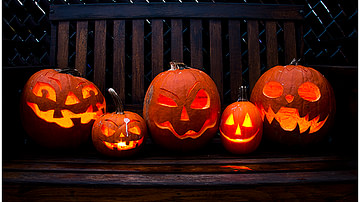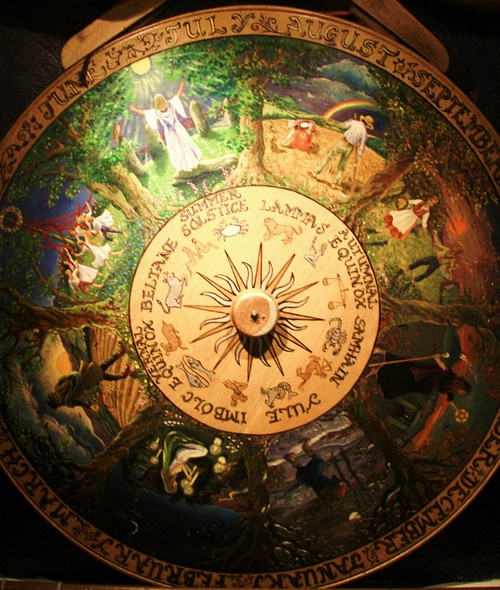
The Wheel of the Year is a symbol of the eight Sabbats (religious festivals) of Neo-Paganism and the Wicca movement which includes four solar festivals - Winter Solstice, Spring Equinox, Summer Solstice, Fall Equinox - and four seasonal festivals - celebrating or marking a significant seasonal change.
Contrary to modern-day Wiccan claims, there is no evidence of an ancient Wheel of the Year in its present form but it is clear that the Celts of thousands of years ago celebrated the festivals the wheel highlights, even if these celebrations were known by another name now long lost.
In the ancient Celtic culture, as in many of the past, time was seen as cyclical. The seasons changed, people died, but nothing was ever finally lost because everything returned again – in one way or another – in a repeating natural cycle. Although time in the modern world is usually regarded as linear, the cyclical nature of life continues to be recognized.
The modern-day Wheel of the Year was first suggested by the scholar and mythologist Jacob Grimm (1785-1863) in his 1835 work, Teutonic Mythology, and fixed in its present form in the 1950s and early '60s by the Wicca movement. The wheel includes the following holy days (most dates flexible year-to-year):
- Samhain (31 October)
- Yule (20-25 December)
- Imbolc (1-2 February)
- Ostara (20-23 March)
- Beltane (30 April-1 May)
- Litha (20-22 June)
- Lughnasadh (1 August)
- Mabon (20-23 September).
These eight festivals are designed to draw one's attention to what one has gained and lost in the cyclical turn of the year. As in the ancient Egyptian civilization (and others), the Celts believed that ingratitude was a 'gateway sin' which then led a person into the darkness of bitterness, pride, resentment, and self-pity. By pausing to reflect upon gratitude for what one had been given in a year, as well as what one had lost but still cherished in memory, one maintained balance.
Samhain
Each Sabbat fell at a time of the year to correspond to the natural cycles of the earth and seasons and Samhain was considered among the most important of these observances. Samhain marks the beginning of the cycle of the year, a kind of New Year's Day.
Samhain (pronounced 'sou-when', or 'so-ween') simply means "summer's end" and marks the end of the season of light and the beginning of the season of darkness. In this context, however, 'darkness' should not be equated with evil or sadness but understood as simply a part of the human condition: there must be regenerative darkness for there to be light.
One gave thanks at Samhain for what one had been given in the previous year and reflected upon what one had lost, especially one's ancestors and loved ones who had passed on to the other side. Physical evidence of the celebration of Samhain in ancient times comes from numerous ancient sites across Ireland, Scotland, Britain, and Wales. Many rituals grew up around Samhain which have become identified with the modern-day observance of Halloween in the United States and are also still observed elsewhere.
Samhain was recognized as a time when the veil between the living and the dead was at its thinnest. This was known as an 'in-between', a time in which the dead could move more easily into the realm of the living. Far from being a frightening concept, however, it was thought that one's ancestors and loved ones who had passed on could visit during this time, and it was customary to prepare a favorite meal and leave out treats for the spirits of the dead. However, if one had wronged someone who had passed on, that spirit could return seeking compensation - and so one wore a mask so as not to be recognized.
As the spirit world was inhabited by all kinds of beings in addition to the souls of the dead, such as fairies and sprites and who could seduce and abduct mortals, one also had to be wary of traveling at night when their powers were most potent. Disguising oneself with a mask and costume also helped to protect a person from these entities.
Halloween bonfires and the practices of so-called 'mischief night' are also traceable back to Samhain. As it was believed that the world began in chaos and was then ordered by the divine forces, it made sense that, on a night when the veil was thinnest between the spirit world and that of mortals, the world might slip back into chaos. Pranks performed the night before the Samhain celebration symbolized chaos while rectifying those pranks the next day meant the restoration of order.
In this same way, the bonfires (originally bone fires in which the offal and bones of slaughtered animals were burned) symbolized a triumph of light and order over darkness. Bonfires are still lighted all across Ireland, Scotland, Britain, and throughout the Hebrides and Orkney on Samhain in recognition of this same concept. This paradigm was reinforced by the next Sabbat of Yule.
Yule
Yule celebrated the Winter Solstice, the shortest day of the year, after which the days grew longer. Scholar Raven Grimassi writes:
In essence, Yule symbolizes the renewing cycles of life, as well as rebirth, rejuvenation, and growth. In ancient Pagan times, the Winter Solstice was the time when people believed the new sun god of the year was born. (32)
In Celtic tradition, trees were considered sacred because they were the homes of deities and spirits. At Yule, a tree was decorated outdoors in honor of the birth of the sun god and gifts were offered. As Grimassi notes, “an evergreen tree was selected because it symbolized the power of life to survive the seasons of the year” (32).
Accompanying the decorated tree was the bonfire which included the Yule Log. The fire symbolized the rebirth of light in the land and new beginnings. People who gathered around the log would sing songs and throw a piece of holly, symbolizing challenges of the past year, into the flames. A piece of the Yule Log was saved to start the next year's fire, symbolizing continuity.
Yule also celebrated the triumph of the Oak King over his brother the Holly King, two symbolic entities who represented the seasons. From Yule to mid-summer, the Oak King reigned over the earth (as the days grew longer) but from mid-summer to Yule, the Holly King gained in power (as days grew shorter and there was less light). The exchange of control over the seasons represented the cyclical nature of life which continued eternally.
Imbolc
Imbolc (meaning "in the belly" from Old Irish and referencing pregnant sheep) is the mid-point between the Winter Solstice and the Spring Equinox and celebrated rebirth and purification. The association of the festival with pregnancy also links it with fertility, hope, and the promise of the future; and these concepts were embodied in the figure of the Celtic goddess Brigid.
Brigid was the goddess of medicine, poetry, fertility, the forge, and sacred springs. Imbolc celebrations involved weaving dolls of Brigid from corn stalks or making sun wheels/swastikas of the same or from wheat stalks representing fertility, continuity, luck, and the life principle of fire.
At Imbolc, one looked forward to an early spring which Brigid also symbolized in her role as a fertility goddess. This association of 2 February with the promise of spring continues to be celebrated in the United States as Groundhog Day and in the Christian tradition as St. Brigid's day where the former sun wheels are now reinterpreted as Brigid's crosses.
Ostara
The promise of Imbolc is met by Ostara, the celebration of the Spring Equinox. Although Ostara is considered an ancient holy day by modern-day pagans, little is known of how it was celebrated prior to the work of Jacob Grimm. The association of Ostara with the rabbit and the egg is quite possibly an ancient one, though, and there is evidence of a link between such symbols and ancient spring celebrations generally.
The name of the festival comes from the Germanic spring/fertility goddess Eostre, mother of the dawn. According to varying traditions, at Ostara the goddess re-emerges from beneath the earth where she has been sleeping for months or it is the time when she becomes pregnant with the sun god who will be born the next Yule or both of these concepts are sometimes combined.
Ostara was observed through feasts and celebrations involving colored eggs, rabbits, chicks, and flowers. The emphasis of the Sabbat was on rebirth and renewal and so the symbol of the egg was of particular importance as was the concept of the labyrinth. The labyrinth dates back to the Neolithic Age in regions as diverse as Ireland, India, and Greece and served as a symbolic representation of detaching one's self from one's present external reality to find some greater meaning within one's self. Grimassi notes how the modern-day practice of the Easter Egg Hunt probably comes from ancient rituals involving a labyrinth and an egg (Grimassi, 39). The ritual act of hunting for the egg would elevate a participant to a liminal state of consciousness.
Beltane
Beltane celebrates light, fertility, and the coming of summer. The name is thought to come from the phrase “Bel's Fire”, a reference to Bel, the Celtic sun god but literally means “bright fire” (Grimassi, 40). As with the other festivals, bonfires played an important part in Beltane observances, but in this case, fire was associated with passion and setting aside one's inhibitions in order to indulge in one's desires.
Dancing was also an integral aspect of the celebration, often taking place around a tree in ancient times. This symbolism evolved into the phallic symbol known as the Maypole which was decorated with long strands of ribbon that participants would hold onto as they danced. The Beltane rituals continued in the observance of May Day throughout Europe and included a May Queen, a young maiden crowned with garlands representing Flora, a fertility goddess associated with flowers and springtime.
As the dark days gave way increasingly to light, all of nature awoke, and this included the unseen entities of the land such as fairies and sprites. While fairies could be benign presences, they were most often seen as mischief-makers who enjoyed playing tricks on humans. To protect against fairies and their spells, the head of the household would place a rowan branch in the ceiling of the house on Beltane and perform a cleansing ritual of carrying a lighted candle from the front door to the back, to the four corners of the house, and from one side of the main room to the hearth, forming a kind of 'net' of eight points symbolizing harmony and balance.
Litha
Litha (possibly the Anglo-Saxon name for June) celebrates the longest day of the year at the Summer Solstice. This was considered the turning point of the year when the Oak King surrendered his reign to his brother the Holly King and the days would become shorter.
The festival of Litha involved bonfires, dancing, fresh fruits and honey cakes, and feasting. It celebrated the triumph of light over darkness and also the knowledge that, going forward, darkness would overtake the light. The shorter days and longer nights to come would only be temporary, however, and light and long days would come again.
Common practices at Litha, besides feasts and fires, had to do with protecting one's self from unseen forces. It was thought that the supernatural entities who were only newly awakened at Beltane were at full strength by Litha and could do one the greatest harm. Sun wheels were woven from stalks and various rituals performed for protection throughout the longest day of the year and especially so if one were married on this day. Marriages (also known as hand-fasting rituals) were common in the month of June and people would choose to be married on Litha as part of the celebration.
Lughnasadh
Lughnasadh (named for the Celtic hero-god Lugh, associated with order and truth) is a harvest festival which acknowledges the passing of the summer into autumn. The first fruits of the harvest were offered to the gods and goddesses. The link between the harvest, coming of autumn, and death is symbolized in the story of Lugh and his foster mother Tailtiu.
Tailtiu was one of the earliest deities of Ireland who selflessly devoted herself to preparing the land for plowing and, after doing so, died from exhaustion. Her son then honored her sacrifice through an annual funeral feast which became Lughnasadh. Horse-racing, archery competitions, fencing matches, races, and physical competitions such as wrestling matches and boxing were all part of the festivities at Lughnasadh, and collectively known as the Tailteann Games. These were all funerary rituals to symbolically honor Tailtiu but also served the community as a final celebration before summer ended.
Mabon
Mabon celebrates the Autumn Equinox through thanksgiving and reflection on what one has gained and lost over the year. The name is a modern-day creation, coined as recently as the 1970's by the Wiccan writer Aidan Kelly, but the practice of observing the Autumn Equinox is quite ancient. Sites such as Newgrange in Ireland, Stonehenge in Britain, Maeshowe and Clava Cairns in Scotland, and more elsewhere, are all known to have been constructed toward astronomical alignments. At Loughcrew, a 5,000-year-old megalithic cairn in the Boyne Valley, Ireland, the Autumn Equinox illuminates the inside chamber's back stone with uncanny precision. It is thought that this cairn, like the other megalithic monuments mentioned, was purposefully built as part of ancient ritual celebrations including Mabon.
Mabon rituals focused on the loss of the goddess who goes into the underworld in autumn but will return in spring. Although this motif is best known through the story of Persephone and Demeter from ancient Greece, almost every ancient civilization had a story involving a god or goddess who goes down into the underworld and later returns to bring life and prosperity to humanity.
In Celtic belief, the fertility god Cernnunos went into the underworld at or around the time of Mabon and returned to earth at Ostara or Beltane as the Green Man. Cernunnos was among the most popular of the Celtic deities, especially in Ireland, where his followers posed the greatest challenge to the early Christian missionaries.
Conclusion
Once Christianity had triumphed over the Celtic pagan beliefs, the holy days of the year became Christianized. Samhain became All Soul's Eve; Yule, of course, became Christmas; Imbolc was turned into Candlemas and Saint Brigid's Day; Ostara became Easter; Beltane was celebrated as the Feast of the Cross and Litha as the Feast of St. John; Lughnasadh became Lammas, “Loaf Mass”, celebrating grains, and the Autumn Equinox became associated with various saints such as Adamnan.
Although the Wheel of Year recognized today is a modern construct, the world-view it represents is quite old. The concept of life and time as an endlessly repeating cycle is evident in the literature, art, and architecture of many ancient civilizations. The Sabbats the wheel highlights, by whatever name they were known in the past, helped the people remain balanced in an uncertain world and, for those who still adhere to the old beliefs, continue to do so in the present.
